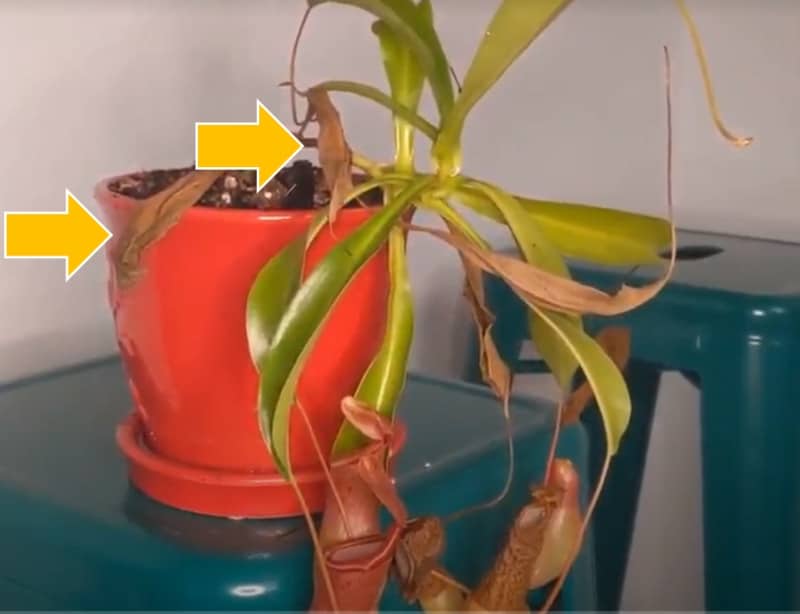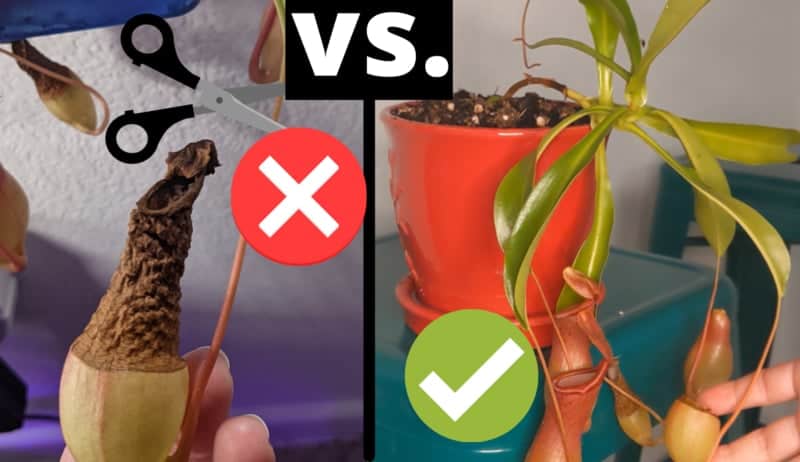Sometimes leaves in pitcher plants start withering and turning black. At that point, it is possible to trim your plant to promote growth and keep it healthy.
Trim pitcher plants by cutting off completely dried up leaves or sections that have withered. Avoid removing any healthy part of your plant. When trimming, employ sharp and sterilized scissors or pruners.
In this article, I will teach you exactly how to trim nepenthes to keep them thriving. The process is not complicated. But, trimming your plant incorrectly can slow down its growth. I also have this video to help you learn the process:
Pitcher Plant Trimming Guide
When trimming pitcher plants, the main idea is to remove only the plant’s dead parts and keep the healthy growth.
The only tool that you will need to trim your plant is a pair of scissors or a pruner; make sure your tool is sharp and sterilized before getting started. To sterilize your instrument, you can clean it with alcohol. Sterilizing your scissors prevents your plant from been exposed to pests from another plant.
Leaves in nepenthes plants have three distinctive parts: the leaf base, the petiole, and the pitcher. The leaf base looks like a standard leaf. The petiole is the filament that joins the leaf base with the pitcher. And the pitcher hangs at the end of the petiole. I will refer to each of these parts as I explain the trimming process. So, keep them in mind 🙂
First, start by removing completely dried up leaves.
Some leaves in your plant might be completely dry, all the way from the leaf base to the pitcher. Remove those leaves by cutting them off as close to the base as possible.

Then, continue by removing sections of the leaves that have withered. Sometimes a pitcher dried up, but the leaf base remains healthy. In that case, do not make the mistake of removing the whole leaf. Instead, cut off only the pitcher by cutting the start of the petiole. And leave the leaf base there. The leaf base will continue to help with photosynthesis.
Finally, in some cases, pitchers start to wither but do not dry up completely. Like in the picture below, the pitcher dried up halfway. For those leaves, you have two options. You can wait until the pitcher has dried up completely and then remove it. Or, you can remove the dried-up section.

If you chose to remove the dried-up section, use your scissors and carefully cut the pitcher’s top (and brown) part. Then, leaf the rest of the pitcher and the leaf alone. The leaf will continue helping with photosynthesis. Plus, if the pitcher is digesting a bug, it will continue to extract nutrients.
So in short… to remove dead leaves in Pitcher plants, do the following:
- Cut off withered leaves as close to the base as possible
- Optimally: remove all dead sections of a leaf, such as a dried up pitcher
Nepenthes Trimming Tips
Trimming or pruning plants brings many benefits. It encourages growth, prevents pests and mold, and makes your plants look heathier. However, the trimming process must be done correctly to offer all of these and more benefits.
The list below includes some useful tips to consider when growing nepenthes and trimming them.
- Trim your plant once every couple of months: Nepenthes do not grow as fast as other carnivorous plants, such as Venus flytraps. There is no need to trim your plant every single time a leaf starts to wither. Instead, prune your plant in batches. These will prevent your plant from suffering from unwanted stress.
- Never attempt to pull dead leaves: Sometimes leaves are so dry, you can pull them off without harming the plant. But, pulling the leaves is not always safe. Extracting dead leaves by pulling them can hurt your plant. I have made this mistake in the past and accidentally removed healthy leaves together with the dried-up one.
- Do not overreact with every black leaf: Dead leaves in any plant, including nepenthes. Make sure to read the next section to verify your plant is healthy, but, in most cases, black leaves are entirely normal.
- Consider taking leaf cuttings when trimming your plant.
Are Black Leaves Normal for Nepenthes?
Often, people tend to get overly worried about their pitcher plant losing a couple of leaves. However, dead leaves are not always an issue.
Brown or black leaves in pitcher plants are normal in most cases. As the leaves age, they start to wither and eventually dry up completely. Still, sometimes, black leaves are a sign of poor growing conditions.
When observing black leaves in your pitcher plant, ask yourself a couple of questions: Are several leaves dying at the same time? Is there new growth spurring from the bottom? have you change your plant’s setup lately? Is your plant going dormant?
A single leaf dying is not a warning sign, but multiple leaves drying up at the same time is a warning sign. Still, if your plant is producing new growth, it has a high chance of remaining healthy. I use a simple yet useful trick to assess the state of my plant. When I trim them, I count their leaves ( a rough estimate for large plants) and write the number down. Then, the next time I trim them, I check if the number is increasing or decreasing.
Some pitcher plant experience a dormancy period during the winter. During dormancy, pitcher plants turn to shed several leaves and reduce in size. The process is entirely normal and necessary for the plant.
Research your plant’s variety to assess its dormancy requirement. If they require dormancy, make sure you provide a suitable environment. While dormant, your plant won’t look at its finest, but it will flourish on the spring more robust than ever.
When plants experience any change, they can suffer from different effects. A drop in humidity, lighting, or temperature changes can make them lose leaves.
How to Reduce Black Leaves in Pitcher Plants
Even though black leaves in pitcher plants are not always a sign of poor growing conditions, it is beneficial to prevent leaves from drying up when possible (this guide can help you reduce black leaves in pitcher plants) (this guide can help you reduce black leaves in pitcher plants).
Here are some of my top suggestions to reduce brown leaves in nepenthes:
Water your plant consistently: Pitcher plants need plenty of water to remain healthy. With our enough water, they won’t produce fluid inside their pitchers (this is how you solve the lack of fluid in the pitchers). With our enough water, they won’t produce fluid inside their pitchers (this is how you solve the lack of fluid in the pitchers).
Sometimes leaves dry up due to the lack of watering. Water your plant often and keep the soil always moist (here is a guide on how to water them to the perfect level). (here is a guide on how to water them to the perfect level).. Please do not flood the ground, but make sure it is humid at all times.
Keep the humidity high: Pitcher plants commonly characterize by thriving in high humidity environments. Each species has different requirements which must be fulfilled.
Consider getting a humidifier if the humidity is too low for your plant. Do not place your plant in a terrarium to increase the relative humidity. A humidifier is much more effective and safe.
Provide enough lighting: Pitcher plants need plenty of lighting (8+ hours) to remain healthy. Expose your plant lots of sunlight to keep the leaves healthy and prevent them from dying.
Introduce your plant to a new climate slowly: Sometimes, changes in the environment can cause brown eaves. Consider acclimating your plant slowly to different locations of climates.
Do not play with the pitchers: Avoid touching your plant excessively as it can generate unwanted stress and black leaves. Only handle your plant when it is necessary to keep the leaves healthy.
Only feed bugs to your plant: Pitcher plants and carnivorous plants in general benefit from consuming bugs. But, they should not consume any human food. Do not feed your plant meat, chicken, fruit, candy, or other types of human food. The food will rot inside the pitchers and unnecessarily kill the leaf.
Feed your plant only when necessary: Pitcher plants only need to capture a bug or two every couple of weeks to experience the nutritional benefits.
Overfeeding your plant can cause black leaves. If you feed your plant manually, only employ one bug at a time, feed a single pitcher, and avoid large bugs with thick exoskeletons (hard to digest).
Pitcher Plant Care 101
Here is a quick overview on Nepenthes care:
| Care Consideration | Recommendation |
|---|---|
| Lighting Requirement: | More than 10 hours of light exposure through natural or artificial light. |
| Watering Requirements: | Only employ distilled water, rainwater, or reverse osmosis water. The soil must be humid at all times. Bog gardens work well. |
| Soil: | Employ nutrient-free carnivorous plant soil (here is a great option on what soil to use): A mixture of peat moss or sphagnum moss and perlite or silica sand. |
| Temperature: | Common temperature range during the growing season: 60 – 80 F (15 – 27 C) |
| Humidity: | > 50% humidity level is recommended |
| Trimming: | Occasionally trim dried up leaves and flowers by cutting them out. |
| Feeding: | Pitcher plants capture bugs on their own. There is no need to feed the plant manually. |
| Fertilizers: | Not required, but you can add fertilizer drops to the pitchers (Maxsea is a good option) is a good option) |
| Pots: | Employ plastic, glazed ceramic, or glass pots with drainage. |
| Repotting: | Repot once a year to promote growth. |
| Dormancy: | Some pitcher plant varieties require dormancy. |
| Outdoor vs Indoor growth: | Can be grown in both outdoor and indoor environments |
For more information on growing pitcher plants, make sure to download the complete care sheet here: Ultimate Pitcher Plant Care Guide .
.
Recommended Products for Growing Carnivorous Plants
Finding the best pots, lights, and soil for carnivorous plants is difficult. I have grown carnivorous plants for over 5 years, and these are the products I use. The links will take you to Amazon to view the prices and full specs:
- Carnivorous Plant Soil
- Carnivorous plant soil: https://amzn.to/422yLZa

- Carnivorous plant soil: https://amzn.to/422yLZa
- Artificial Lighting
- Small plant light for 1-2 plants: https://amzn.to/3oQsmSj

- T8 LED light fixture for multiple plants (6500k Cool White): https://amzn.to/3uWoeh2

- Small plant light for 1-2 plants: https://amzn.to/3oQsmSj
- Pots and Miscellaneus
- Nursery pots for single plants: https://amzn.to/3oL8YGq

- Nursery pots for single plants: https://amzn.to/3oL8YGq
- TDS meter to measure water quality: https://amzn.to/3g8VKLI

- Dried crickets to feed carnivorous plants: https://amzn.to/34QEnKv

